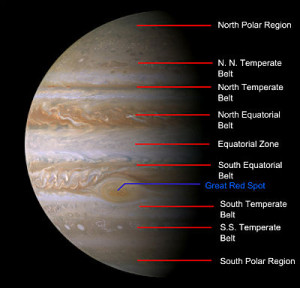This month offers prime viewing for one of the most interesting objects in our Solar System as Jupiter is now well positioned for observation from twilight to dawn.
Jupiter is easily visible to the naked eye as the brightest star-like object in the sky. Currently it is found in Cancer, which can be a difficult constellation to locate in my suburban sky – look for it between Gemini and Leo.
Jovian Features

Annotated picture of Jupiter taken by the Cassini spacecraft on December 29, 2000 (Credit NASA/JPL for original picture).
The planet offers a host of features for users of small telescopes. At powers around 10x the four Galilean moons can be seen nicely aligned with the planet. Increase the magnification to 40x and the main equatorial belts stand out clearly. Going to 100x and higher reveals more belts and zones.
For many observers of Jupiter the Great Red Spot (GRS), an enormous storm that has raged for hundreds of years, is a sought after highlight. Magnifications of around 130x are a good starting point for your first views of the GRS.
Catching the Great Red Spot
In order to have a chance at seeing the GRS it needs to be visible when you are viewing. Due to Jupiter’s rate of rotation the GRS crosses the face of the planet about every 10 hours. How can you find out when the spot will be visible? Project Pluto has tables for calculated GRS transits for each day of 2015. Note that listed times are in Universal Time and you will need to adjust for your local time; for example to get EST I need to subtract 5 hours from UT.
The calculated transit times indicate when the GRS will be positioned on the meridian – right in the center of the disk. This is the optimal time to view but you should still be able to view it within an hour on each side of the transit time.
What to Expect
In decades past the Great Red Spot may have lived up to its name but as of late it is much more difficult to discern due to lightening of color.
While the Great Red Spot can be seen in surprisingly small telescopes, just how prominently the GRS stands out from the Southern Equatorial Belt depends on the steadiness of the atmosphere while you are viewing and the aperture of your telescope. My experiences viewing the GRS are as follows:
| Telescope Aperture | Observation |
| 60-70mm | GRS visible as a discernible protrusion from SEB; knotty appearance |
| 80-90mm | Separation from SEB begins to be discerned |
| 100mm+ | Clear, defined separation from the SEB |
If your first attempt at viewing the GRS is unsuccessful, don’t be discouraged. It does take some practice to accustom the eye to viewing fine planetary detail through the telescope. Keep viewing and you will likely see an increase in the details observed over time. Your first glimpse of the Great Red Spot will be one to remember!
-Dave
Original content copyright 2015 by David Philips. All Rights Reserved. This post may contain links to affiliate sites; sales through affiliate links may benefit this site.